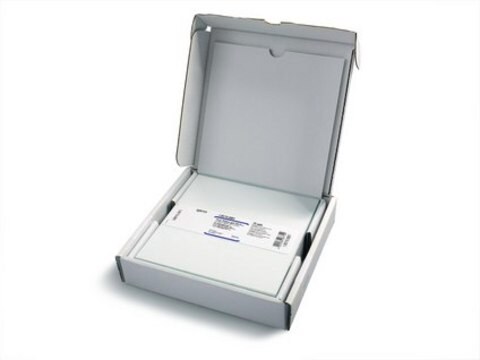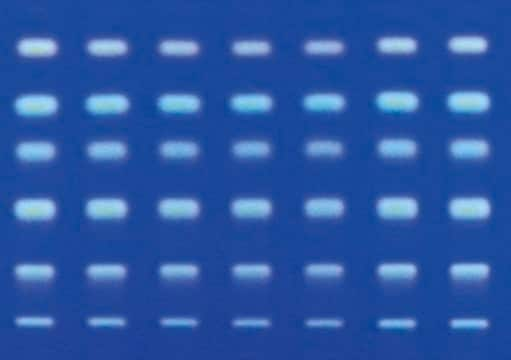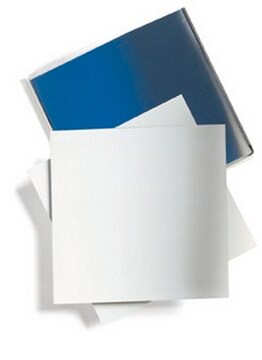1.05626
TLC-Platten, Kieselgel 60
pkg of 50 plates, plate L × W 20 cm × 10 cm, glass support
Synonym(e):
Silica Gel 60 TLC Plates
About This Item
Empfohlene Produkte
Materialien
glass support
silica gel 60 matrix
Qualitätsniveau
Leistungsmerkmale
binder Organic Polymer
fluorescent indicator: no
Verpackung
pkg of 50 plates
Methode(n)
thin layer chromatography (TLC): suitable
Schichtdicke
250 μm
Platte L × B
20 cm × 10 cm
Partikelgröße
10-12 μm
Porengröße
60 Å medium pore diameter
Lagertemp.
2-30°C
Verwandte Kategorien
Allgemeine Beschreibung
Anwendung
- An eco-friendly and cost-effective HPTLC method for quantification of COVID-19 antiviral drug and co-administered medications in spiked human plasma.: This study by Ghozzy et al. (2024) presents a high-performance thin-layer chromatography (HPTLC) method using Silica gel 60 TLC plates. The method is used for quantifying antiviral drugs and co-administered medications in human plasma, emphasizing its eco-friendly and cost-effective nature (Ghozzy et al., 2024).
- Identification of variety-specific metabolites of basil by high performance thin layer chromatography-assisted metabolic profiling techniques.: Wulandari et al. (2023) used Silica gel 60 TLC plates in HPTLC to identify metabolites specific to different basil varieties, showcasing the technique′s capability in plant metabolomics (Wulandari et al., 2023).
- Separation and quantification of azelnidipine and chlorthalidone in a synthetic mixture using optimized HPTLC method.: Raimalani and Kotadiya (2024) developed an HPTLC method for separating and quantifying azelnidipine and chlorthalidone in a synthetic mixture, utilizing Silica gel 60 TLC plates for their analytical process (Raimalani and Kotadiya, 2024).
- Isolation, development and validation of HPTLC method for the estimation of β-carotene from Gymnosporia senegalensis (Lam.) Loes.: Jain et al. (2023) describe the isolation and validation of an HPTLC method for estimating β-carotene from Gymnosporia senegalensis, using Silica gel 60 TLC plates, highlighting its application in phytochemical analysis (Jain et al., 2023).
- Simultaneous Determination of Ceftazidime in Three Different Pharmaceutical Preparations Combined with Either Tazobactam, Tobramycin or Sulbactam by HPTLC-Spectrodensitometric Method.: Salem et al. (2023) applied Silica gel 60 TLC plates in their HPTLC-spectrodensitometric method to simultaneously determine ceftazidime in various pharmaceutical preparations, demonstrating its utility in pharmaceutical analysis (Salem et al., 2023).
Verlinkung
Hinweis zur Analyse
Porenvolumen (N₂-isotherm): 0,74–0,84 ml/g
d 50 (Laserbeugung, Kornanalyse): 9,7–11,7 µm
Schichtdicke: 210–270 µm
Dickenschwankung pro Platte: ≤ 35 µm
Chromatographischer Test:
Farbstofftest
hRf-Werte
- Bleu VIF Organol, Farbstofftest, lipophil:
11–25
– Ceresschwarz G, Farbstofftest, lipophil: 34–48
- Ceresviolett BRN, Farbstofftest, lipophil: 52–67
Trennzahl (Farbstofftest, lipophil): ≥ 10,5
Typischer Wert gemessen an einer konditionierten Platte
Eluent: Toluol (45 % rel. Feuchte)
Lagerklassenschlüssel
10-13 - German Storage Class 10 to 13
Analysenzertifikate (COA)
Suchen Sie nach Analysenzertifikate (COA), indem Sie die Lot-/Chargennummer des Produkts eingeben. Lot- und Chargennummern sind auf dem Produktetikett hinter den Wörtern ‘Lot’ oder ‘Batch’ (Lot oder Charge) zu finden.
Besitzen Sie dieses Produkt bereits?
In der Dokumentenbibliothek finden Sie die Dokumentation zu den Produkten, die Sie kürzlich erworben haben.
Unser Team von Wissenschaftlern verfügt über Erfahrung in allen Forschungsbereichen einschließlich Life Science, Materialwissenschaften, chemischer Synthese, Chromatographie, Analytik und vielen mehr..
Setzen Sie sich mit dem technischen Dienst in Verbindung.




